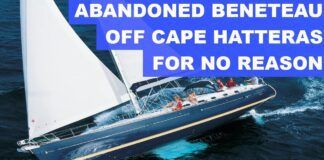As is typical of C&Cs, owners give the boat high marks for quality of construction, and in general, their enthusiasm is justified. The boat does, however, have a potential weak point.
Hull: Like most C&Cs, the 40 was built with a balsa-cored hull. The result is a hull that is extremely stiff for its weight, but balsa coring is not without its potential for problems. In the event of delamination or rupture of the hull skin, the balsa coring can absorb moisture. Moisture penetration of the outer laminate could ultimately reach the balsa coring. It is imperative that a balsa-cored hull be carefully examined by a knowledgeable surveyor before purchasing a used boat.
Deck: The deck of the C&C 40 is also balsa cored. It too should be carefully sounded to check for delamination. In our opinion, deck delamination is potentially a very serious problem in almost any boat-not just this one-and the cost and difficulty of repair is frequently grossly underestimated.
Hull-to-deck joint: C&C uses a basic inward-turning flange for the hull-to-deck joint, with a through-bolted aluminum toerail providing the mechanical fastening. Unlike many builders, C&C uses butyl tape in this joint. Butyl tape has no structural or adhesive properties; it just keeps the water out. Uniform tensioning of the bolts in the joint is important with this type of bedding compound. Leaks in the joint can frequently be solved by careful re-torquing the bolts, but don’t tighten them so much that all the compounds squeezed out.
Rudder and keel: Like most late IOR boats, the C&C 40 hull is virtually flat on the bottom, with the shallow bilges having little depth for strong transverse support. The keel has a relatively short root chord, so the keel stresses are very concentrated. In a hard grounding, the trailing edge of the keel can be levered up into the hull, resulting in devastating damage.
We examined one C&C 40 that ran into a rock at about 7 knots during a race. The aft edge of the keel punched through the bottom of the boat, and the owner just managed to power the boat 20 miles to a boatyard, which hauled her instantly to keep the boat from sinking. Over the years, we have looked at several C&C 40s with similar, though less dramatic, bottom damage as the result of grounding while racing. Remember that with this boat, you need more than 7 feet of water under you. Beginning with 1981 models, both the deck and rudder installations were more heavily reinforced. Most boats were retrofitted with these upgrades, and you should check with previous owners to see that they were done. On a used boat, it is also a good idea to pull out the alloy rudder stock and inspect it for corrosion and the rudder for water ingress.
Rig: The mast is made from a reasonable section for a racer/cruiser. It is bendy enough for sail control when racing, but not nearly as fragile as you would find on a flat-out IOR racer of the same rig size.
Most of these boats are equipped with a hydraulic backstay, with the babystay adjusted by a traveler on a track mounted atop the cabin. Boats that have been set up for racing may also have hydraulics for the babystay and vang. Without hydraulic mast controls, its virtually impossible to take advantage of the spars sail-shaping capabilities.



































